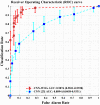Pulmonary Diffuse Airspace Opacities Diagnosis from Chest X-Ray Images Using Deep Convolutional Neural Networks Fine-Tuned by Whale Optimizer
- PMID: 34873379
- PMCID: PMC8635480
- DOI: 10.1007/s11277-021-09410-2
Pulmonary Diffuse Airspace Opacities Diagnosis from Chest X-Ray Images Using Deep Convolutional Neural Networks Fine-Tuned by Whale Optimizer
Abstract
The early diagnosis and the accurate separation of COVID-19 from non-COVID-19 cases based on pulmonary diffuse airspace opacities is one of the challenges facing researchers. Recently, researchers try to exploit the Deep Learning (DL) method's capability to assist clinicians and radiologists in diagnosing positive COVID-19 cases from chest X-ray images. In this approach, DL models, especially Deep Convolutional Neural Networks (DCNN), propose real-time, automated effective models to detect COVID-19 cases. However, conventional DCNNs usually use Gradient Descent-based approaches for training fully connected layers. Although GD-based Training (GBT) methods are easy to implement and fast in the process, they demand numerous manual parameter tuning to make them optimal. Besides, the GBT's procedure is inherently sequential, thereby parallelizing them with Graphics Processing Units is very difficult. Therefore, for the sake of having a real-time COVID-19 detector with parallel implementation capability, this paper proposes the use of the Whale Optimization Algorithm for training fully connected layers. The designed detector is then benchmarked on a verified dataset called COVID-Xray-5k, and the results are verified by a comparative study with classic DCNN, DUICM, and Matched Subspace classifier with Adaptive Dictionaries. The results show that the proposed model with an average accuracy of 99.06% provides 1.87% better performance than the best comparison model. The paper also considers the concept of Class Activation Map to detect the regions potentially infected by the virus. This was found to correlate with clinical results, as confirmed by experts. Although results are auspicious, further investigation is needed on a larger dataset of COVID-19 images to have a more comprehensive evaluation of accuracy rates.
Keywords: COVID-19; Chest X-rays; Deep convolutional neural networks; Whale optimization algorithm.
© The Author(s), under exclusive licence to Springer Science+Business Media, LLC, part of Springer Nature 2021.
Conflict of interest statement
Conflict of interestThe authors declare that there is no conflict of interest regarding the publication of this paper.
Figures










Similar articles
-
Improved deep convolutional neural networks using chimp optimization algorithm for Covid19 diagnosis from the X-ray images.Expert Syst Appl. 2023 Mar 1;213:119206. doi: 10.1016/j.eswa.2022.119206. Epub 2022 Nov 4. Expert Syst Appl. 2023. PMID: 36348736 Free PMC article.
-
Real‑time COVID-19 diagnosis from X-Ray images using deep CNN and extreme learning machines stabilized by chimp optimization algorithm.Biomed Signal Process Control. 2021 Jul;68:102764. doi: 10.1016/j.bspc.2021.102764. Epub 2021 May 11. Biomed Signal Process Control. 2021. PMID: 33995562 Free PMC article.
-
DCNN-FuzzyWOA: Artificial Intelligence Solution for Automatic Detection of COVID-19 Using X-Ray Images.Comput Intell Neurosci. 2022 Aug 9;2022:5677961. doi: 10.1155/2022/5677961. eCollection 2022. Comput Intell Neurosci. 2022. PMID: 35965746 Free PMC article.
-
Evolving deep convolutional neutral network by hybrid sine-cosine and extreme learning machine for real-time COVID19 diagnosis from X-ray images.Soft comput. 2023;27(6):3307-3326. doi: 10.1007/s00500-021-05839-6. Epub 2021 May 10. Soft comput. 2023. PMID: 33994846 Free PMC article.
-
Development and integration of VGG and dense transfer-learning systems supported with diverse lung images for discovery of the Coronavirus identity.Inform Med Unlocked. 2022;32:101004. doi: 10.1016/j.imu.2022.101004. Epub 2022 Jul 8. Inform Med Unlocked. 2022. PMID: 35822170 Free PMC article. Review.
Cited by
-
BO-ALLCNN: Bayesian-Based Optimized CNN for Acute Lymphoblastic Leukemia Detection in Microscopic Blood Smear Images.Sensors (Basel). 2022 Jul 24;22(15):5520. doi: 10.3390/s22155520. Sensors (Basel). 2022. PMID: 35898023 Free PMC article.
-
Deep Transfer Learning for the Multilabel Classification of Chest X-ray Images.Diagnostics (Basel). 2022 Jun 13;12(6):1457. doi: 10.3390/diagnostics12061457. Diagnostics (Basel). 2022. PMID: 35741267 Free PMC article.
-
Optimizing VGG16 deep learning model with enhanced hunger games search for logo classification.Sci Rep. 2024 Dec 30;14(1):31759. doi: 10.1038/s41598-024-82022-5. Sci Rep. 2024. PMID: 39738231 Free PMC article.
-
Improved Latin hypercube sampling initialization-based whale optimization algorithm for COVID-19 X-ray multi-threshold image segmentation.Sci Rep. 2024 Jun 9;14(1):13239. doi: 10.1038/s41598-024-63739-9. Sci Rep. 2024. PMID: 38853172 Free PMC article.
-
Artificial Intelligence-Enabled Electrocardiography Predicts Left Ventricular Dysfunction and Future Cardiovascular Outcomes: A Retrospective Analysis.J Pers Med. 2022 Mar 13;12(3):455. doi: 10.3390/jpm12030455. J Pers Med. 2022. PMID: 35330455 Free PMC article.
References
-
- Abdel-Basset M, Mohamed R, Elhoseny M, Chakrabortty RK, Ryan M. A hybrid COVID-19 detection model using an improved marine predators algorithm and a ranking-based diversity reduction strategy. IEEE Access. 2020;8:79521–79540. doi: 10.1109/ACCESS.2020.2990893. - DOI
LinkOut - more resources
Full Text Sources
